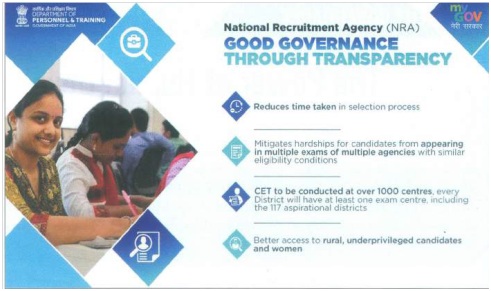

Introduction
Economically, an efficient human capital leads to greater prosperity, higher innovation, and value-addition within the economy. Thus, it is a no-brainer that investing in human development is both socially beneficial and economically rewarding.
This is also the guiding principle behind the government's vision and approaches towards India's public administration- effective and efficient governance that enhances ease of living for its citizenry. The Prime Minister's mantra of 'minimum government, maximum governance' has been repeatedly espoused by him with regards to reducing red-tap ism and bureaucratic inefficiencies, reducing the overwhelming role and presence of the government wherever unnecessary.
Transforming India’s Public administration
- The government has made its core agenda to reform and transform India's public administration apparatus to matchthe needs and expectations of a rising global economic power.
- Be it reducing the number of compliances or announcing the formation of a national recruitment agency for conducting exams for government recruitment, this space is undergoing reform unlike any other.
- In the same context, the Prime Minister recently asserted in the Parliament that the government had no business to be in business- and stressed upon the need for a reduction in bureaucratic procedures where none are required.
- It is worth mentioning here that the creation of a nationalrecruitment agency (NRA) to conduct examinations for themiddle and lower rungs of government service is anotherexample of streamlining public administration within thecountry and replacing the current web of agencies andexaminations.
- On the back of the technological changes takingplace globally, the government's aggressive push towards digitising governance processes has been widely praised.Beginning with the umbrella campaign, 'Digital India,'the country has witnessed a massive surge in digitalservices, ranging from digital payments to JAM Trinityand DBT.
- With record low prices of data and record-highconsumption of data, India has grown leaps and bounds interms of digital infrastructure and access to and variety ofavailable digital resources such as SWAYAM portal (onlineeducation), e-Aadhaar services, online PAN, Voter card,and Income Tax Return (ITR) services, online banking, and portals like MyGov, DigiLocker, Udyami, and e-visaservices.
- The mammoth network of government presencein digital space is a testament to the importance given bythe PM to putting e-governance at work for the commonpeople and simplify governmental processes for them tothe extent possible.

Role of Public Sector Enterprises
- A major marker of government's presence in thecountry is the state-owned enterprises commonly known as Public Sector Enterprises (PSEs), present in areas ranging from banks to telecom and from insurance to coal.
- Over the years, the highest echelons of government machinery including the PM, have called for a divestment of the government's majority share in these enterprises and corporatizing them to achieve higher productivity and promote better business practices in these vast institutions.
- The government's ambitious targets on divestment and an impressive result in achieving them in the past bodes well both for the government and the citizens in that it not only reduces government's costs arising out of administrative functions, monetary leakages,and sub-optimal utilisation ofits resources but also benefitsthe public through betterand more transparent use oftaxpayers' money and highercompetitiveness.
Conclusion
This article explored the wide-ranging reforms undertaken by the Indian government to overhaul the governance mechanisms in the country. Decisions like rapidly disinvesting from sick, underperforming PSUs, setting up a national recruitment agency for government recruitment, promoting the lateral entry of experts into government service, encouraging digitization to improve governance outcomes will also stems bureaucratic hurdles, redtape, corruption and policy unpredictability for foreign and domestic investors. Doing this will also take India's economic and social progress to the grassroots, to the most vulnerable sections of society, thus, truly shaping the future of an emergent global power.
|
Additional Information 1) Catch the Rain
2) The Rebellions of Palayakkars
3) Indian SARS-CoV-2 Genomics Consortium
|
Related Articles

